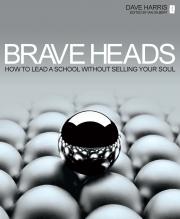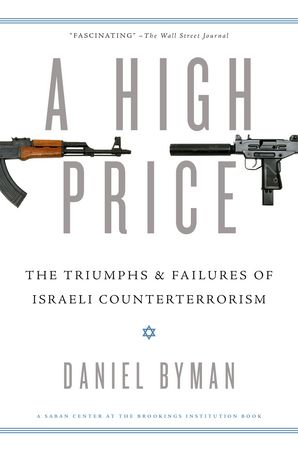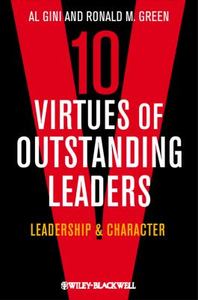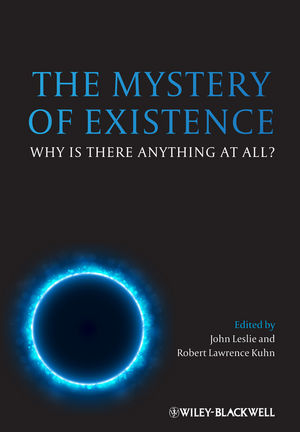
Brave Heads - How to lead a school without selling your soul by Dave Harris. Reviewed by Paula Anderson
The Magic of NLP Demystified by Bryan Lewis. Reviewed by Michael Mallows
A High Price - The triumphs & failures of Israeli counterterrorism by Daniel Byman. Reviewed by Sep Meyer.
10 Virtues of Outstanding Leaders - Leadership & Character by Al Gini and Ronald M. Green. Reviewed by Terry Goodwin.
The Mystery of Existence - Why is there anything at all? Edited by John Leslie and Robert Lawrence Kuhn. Reviewed by Joe Sinclair
Brave Heads - How to lead a school without selling your soul - by Dave Harris. Paperback. 180 pages. £18.99 ISBN 13: 9781781350485. Publisher: Crown House Ltd. Also Kindle ebook. ISBN 10: 1781350485
For any new Head or for those considering Headship this is one to read as it is written by a Principal with thirty years plus of experience who has clear insight into the challenges faced by a Head in an ever changing educational environment. The useful tips at the end of every chapter serve to be practical and are summarised at the end of the book too. The content throughout focuses on what is really important in building a school community and allows the reader to examine their own situation.
There is good use of analogies to explain a point in an interesting way, encouraging the reader to remember the point being made. Dave Harris explains how common sense should prevail when he sets up his five essential school rules, how bravery is ‘keeping your eyes on the marathon whilst you are performing the sprint’ and not of course forgetting the ‘wonder’ room.
He cleverly describes examples where, if there is a problem to be addressed, this is done through positive means rather than highlighting the issue. In other words he would support or arrange anything that would serve to develop self- esteem and a new found enthusiasm for learning.
In one chapter he outlines four types of leadership as fat controller, nurturer, gardener and corporate executive which all serve to illustrate that you can be any combination of these at any given time, but that you do not have to be a successful leader to fit a specific profile.
He captures the reader’s interest in every chapter which encourages you to want to read on.
The Magic of NLP Demystified by Bryan Lewis, 197 pages. Paperback. ISBN 9781845908034, 1845908031. £16.99 . Published by Crown House Publishing. Also available in kindle version.

The Magic of NLP Demystified, according to its author, is "the culmination of decades of training and self-exploration within the confines of a specific sphere of study".
The book will be of interest and benefit to anyone
whose work or interests include or require effective communication; teachers,
trainers, entrepreneurs, managers, mediators, parents, salespersons and, of
course, coaches, counsellors and therapists.
It explains some of the basic building blocks of NLP, which can be thrilling for
newcomers to discover, and even 'old hands' who are steeped in NLP might enjoy a
revisit and, dare I say it? Some revision!
The first edition of this book (1990) was one of the books I most frequently recommended to people who asked me for an accessible introduction to NLP. I was – and remain – enamoured of NLP and was (over?) zealous in lauding it whenever the opportunity presented itself.
Byron Lewis met Frank Pucelik and Leslie Cameron (now Lebeau), who took him through 'a powerful therapeutic experience' that had a lasting effect. He wanted to “learn that kind of Magic!” and became a member of a small experimental-research group in California. He joined a growing number of people who were studying the magic of therapeutic growth and change. Two charismatic individuals – Richard Bandler and John Grinder – were the epicentre of the group, and the author started to keep notebooks that detailed his learning experiences. In time he developed his own style, and labelled his notes “A Model for a Process Theory of Personality” thinking he had found 'the right track.' In time he realised he had set a trap for himself.
He discovered that his model was continually
stretched, extended, expanded, and enlarged. It was also shrunk, crushed,
pierced, and mutilated. He created 'a symbolic representation of the wonderful
(and enjoyable) contradictions confronting him', and 'recognition of the trap he
was escaping'
The book presents models of basic Meta principles which underpin the 'magic' of
communication that is intended to influence change. Lewis alerts us to the need
to avoid
the trap that we might (and I certainly did) fall into if we get snared or
limited by a model if we do not remain open to experience.
The book is divided into four sections, all about models:
Pages 5 – 32 Models
Pages 39 – 73 The Communication Categories Model
Pages 77 – 136 The Meta Model
Pages 143 – 161 The Visual Model
The language is elegantly lucid, despite the inevitable 'jargon' because, for newcomers, the 'technical terminology' can be a tad daunting, but it's well worth staying with it for the wealth of information and inspiration that is to be found within.
The bibliography lists 70 or so books, not all about NLP, but all relevant to what the book is about.
I'd like to quote a paragraph from Tosey and
Mathison (2007(1)) that Lewis refers to,
because it sums up what, in my opinion, facilitates and enhances the best of
what NLP and NLPers should be about. I think this book, like its
predecessor, does – only more so!
“In common with the aspirations of the human potential movement, NLP takes
issue with the archaeological emphasis of Freudians, on digging into the past in
order to understand the present. NLP is firmly constructivist in the sense that
it perceives all experience, including memories, as (re)created in the present”
(p.5).
Michael Mallows
(1)Tosey, P. and Mathison, J. Neuro-Linguistic Programming: A Critical Appreciation for Managers and Developers. Basingstoke, UK:Macmillan, 2009
A High Price - The triumphs & failures of Israeli counterterrorism by Daniel Byman. 464 pages. Paperback. Price £14.99. ISBN 978-0-19-993178-1. Published by Oxford University Press.

'Israelis are people who never take "yes" for an answer' wrote Abba Eban in his Autobiography.
It had been on my bookshelf, unread, for some 3 decades before I began reading it a few weeks ago, delighting in the crispness and lucidity of Eban's English, and the introduction to the behind-the-scenes diplomacy to which he was heir for so long, during such an exciting period of history and, in particular, the painful birth pangs and subsequent growing pains of the Israeli nation.
This may seem quite a digression from a review of A High Price, but it actually is not. By a piece of Jungian synchronicity, the review copy of A High Price was offered to me just as I was approaching Eban's account of the diplomatic and military background to the Yom Kippur war of 1973, and very close to the end of the Autobiography itself. I was thus already immersed in Israeli matters and ready for another "blockbuster" to replace the Eban, particularly one whose first three chapters covered the same period, before carrying the story through the remainder of the 20th and the first decade of the 21st centuries, albeit from a totally different vantage point.
Diplomacy some may regard as the antithesis of counter-terrorism; it may, in effect, equate to Churchill’s “jaw-jaw” as an alternative to “war-war”. In fact it is not that clear cut. The jaw-jaw of diplomatic efforts to secure agreement to unacceptable political solutions (as Byman’s book makes clear) regularly exists pari-passu with military and terrorist activities and their counter-terrorist corollaries.
The main problem Byman faces (or, perhaps it would be more correct to say, gives himself) throughout this book is his effort to be fair and impartial to all parties involved in these activities. This intention is wholly admirable, but produces a morass into which Byman has to avoid stepping. From the very beginning of its existence as a Nation, Israel has had to combat blatant attacks on its national integrity from the Arab countries that surround it. In these circumstances it was inevitable that a counter-terrorism policy needed to be adopted. The difficulty that is faced by anyone studying, or writing about, this situation is to identify where and when counter-terrorism becomes terrorism and vice versa.
To examine and identify how effective have been Israel's counter-terrorism policy and methods it is necessary to consider what have been their consequences. What cannot be denied - indeed what Mr Byman does affirm - is that the effect of Israeli counter-terrorism has been to act as a catalyst for the development of Palestinian resistance movements such as the PLO, the Fatah movement, Hamas and Hizbollah.
Each of these organisations may be identified as originators of a variety of terrorist activities against and within the State of Israel. Each of them may, with justification, point to similar acts of terrorism performed by Israeli factions to which they "have merely responded". In fact, if one is considering the ebb and flow of terrorist and counter-terrorist activity, the significance and justification of each is merely a matter of degree and not legitimacy. Counter-terrorism may be very effective in the short-term; in the case of Israeli counter-terrorism, however, it would be hard to deny that its long-term effect has been to increase resistance and exacerbate the reasons for disaffection.
And yet it is hard to know what alternative exists. Certainly none is proposed by Mr Byman. But then this presumably is not in his brief. Over the years, Jewish response to actual or perceived outrages has been more instinctive than calculated. Yet Byman has pointed out that on at least one occasion Israeli reaction to a terrorist situation has been considerably less than would have been an United States response to the same situation. Another major difference between the parties has been the ostensible Israeli reliance on legality, a concern that apparently is not shared by some of its adversaries. But given the nature of the different shades of character within Israel, the religious and secular divides, the right-wing and left-wing concerns, even that major difference counts for little in the face of some of the atrocities that have been committed in the name of - if not by - Israel. The Lavon Affair, for example, that dragged on for years from 1954 when Jewish conspirators in Cairo were arrested (two of them executed), to 1969 when Pinhas Lavon was cleared of complicity (unconvincingly to some), to be set against, for instance, the Munich Olympic attack. How does one weigh the pros and cons in the balance?
Daniel Byman does his best. But he admits that he has no really satisfactory answer to these questions.
So I have merely scratched the surface of Mr Byman's admirable work of scholarship. The background he provides - which he has so effectively researched - to much of the history of Middle Eastern intrigue makes fascinating reading. And if the conclusions are, in fact, inconclusive, this must be because there can be no hard and fast conclusion in the shadowy world of terrorism and counter-terrorism.
Many decades ago, in one of his comedy sketches, American comedian Shelley Berman had his ‘wimpish’ protagonist complain to his accusatory girl-friend: “Ah, Shirley, I can’t go along with that. When two people are holding hands, who can say which hand is doing the sweating?”
When adversaries are facing each other, with arms upraised, across the counter-terrorist divide, who can say which hand is holding a rifle and which an olive branch?
The answer must be that there are no easy answers.
Sep Meyer
10 Virtues of Outstanding Leaders - Leadership & Character by Al Gini and Ronald M. Green. 220 pages. Price £14.99. ISBN: 9780470672303. Published by Wiley-Blackwell.

This is a book of two parts. The first is an introduction to the qualities of leadership, with the emphasis on ethics. The second considers the qualities of various "leaders" through the centuries, in no immediately obvious chronological or consecutive order. Looking at the Table of Contents, I wondered why.
There are - as the authors themselves acknowledge in their prologue - already far too many books that focus on the idea of leadership. They also then pose the question: why are they offering another book on the subject?
I read my review copy of the book hoping that, by the end, I might have the answer to both questions.
I did!
Firstly, let me say it is a "good read". Some of the subjects for the authors' investigation were a bit unexpected. But they were actually more interesting on that account. Thus I was a bit surprised to find Oprah Winfrey nestling between Winston Churchill and three American Presidents, the last of which (Franklin Delano Roosevelt) obligingly relinquished a substantial part of his section to his contemporary (though hardly similarly ethical) leader Adolf Hitler.
But I out-gallop myself. The first section of the book, subtitled Character Leadership was, for me, the most enlightening. It deals with the philosophical considerations of leadership according to the authors' set of values. The ethical basis of their thesis, springing from the contention* that leadership ultimately is judged by results, is traced back more than 2000 years, drawing for examples on, among others, Platonic and Aristotelian ethics and St Augustine's De Civitate Dei.
They call leadership without ethics misleadership. (p.xiv) and in Chapter 2 go on to define and illustrate this concept. Chapter 3 is devoted to "character", while the following chapter concerns itself with leadership in business and the workplace. It is the last chapter in this first part of the book where we finally get to grips with the Ten Virtues. These are not only identified and described, but are each associated with a specific leader who demonstrates the specific virtues of that characteristic, and are then examined in detail in the second section of the book.
Thus:
1. Deep Honesty. The example chosen for this virtue (or trait of character) is James Burke.
2. Moral Courage. Epitomised by Abraham Lincoln and Rosa Parks.
3. Moral Vision. The "ability to clearly understand the moral stakes of a decision . . . " was one of the traits that characterized Winston Churchill.
4. Compassion and Care. Empathy is a major characteristic of Oprah Winfrey.
5. Fairness. This has to be seen and recognised by everyone was a belief of Dwight D. Eisenhower.
6. Intellectual Excellence. The authors have given this virtue two components: curiosity and open-mindedness. They have chosen Franklin D. Roosevelt as the exemplar.
7. Creative Thinking shows itself in "new ways of accomplishing organisational goals" as demonstrated by Herb Kelleher of Southwest Airlines.
8. Aesthetic Sensitivity. "I want to put a ding in the universe" is the quote that heads the section on Steve Jobs.
9. Good Timing. "Great leaders possess this virtue and exercise it in their most important strategic decisions." As did General Charles de Gaulle.
10. Deep Selflessness. If the words do not sufficiently impart the meaning, then the choice of Martin Luther King as its model certainly does. I guess Albert Schweitzer might have been equally acceptable, but who am I to quibble over the choice of an American by American authors.
So we come to the second and lengthiest part of this book, subtitled Leadership in Action. This, I venture to suggest, will be the section of most interest to the majority of readers and, to describe why it is provided and what it is intended to produce here is what the authors themselves have written at the end of their Prologue.
". . . this is a book about characters with character. After several chapters that ground the importance of ethics in business and present the key virtues of outstanding leaders, we turn to those leaders themselves. As Aristotle argued, we need examples, the testimony of others, to understand how to form ourselves as leaders. In what follows, chapter by chapter, we depict individuals who in real-life situations act out the virtues that marked them as great leaders. Learning virtues is very much a matter of habit and imitation. By holding up these paragons of virtue, we aim to provide a useful tool for enhancing excellence in organizations."
If this was, indeed, their intention, I believe they have been entirely successful. Also, as I said earlier, it's a very good read. And, if that phrase seems to trivialise it, let me add that it includes an abundance of references and signposts to sources of further study, which gives it undoubted academic cachet.
All in all, a very welcome addition to the businessman's (and potential leader's) library bookshelf.
[PS: One minor "gripe": Perhaps I'm old-fashioned, but it still grates on me to see "mutual" used, when "common" is more accurate, as in ". .. changes that reflect their mutual purpose and goals" (p.5), where the authors clearly do not mean the purpose and goals they each have to the other, but purpose and goals that they share. Yes, I know, I'm a pedant where language is concerned!]
* Hardly theirs alone, but shared by the majority of writers on the subject of leadership.
Terry Goodwin
The Mystery of Existence - Why is there anything at all? Edited by John Leslie and Robert Lawrence Kuhn. 314 pages. Paperback. Price £17.99. ISBN 978-0-470-67355-3. Published by Wiley-Blackwell

"I ofen looked up at the sky an' assed meself the question - what is the moon, what is the stars?" - Captain Boyle, Act I, Juno and the Paycock by Sean O'Casey.
I defy any thinking person to deny that they have ever considered the origins of life and matter. I recall, as a grammar school teenager in South Wales, walking the streets of Llanelli with a school friend one evening, debating cause and effect. Trying to work out how it might be possible to arrive at a First Cause which would not inevitably be the effect of a previous cause. I think it gave both of us headaches.
To the question "Why is there anything at all?" there is a simple answer. Why not? Any other answer is absurd. It is because it is. And if it were not, it would be even more absurd to ask: "Why is there nothing at all?"
Given the circumstance that the foregoing paragraph has any merit, a reviewer might be excused for thinking: "Why, then, publish an entire book on the subject?" And why, even more absurdly, produce a commentary on that publication?
Which is precisely what I am trying to establish.
The thing is that the editors have collected views on the existence of reality from the most prestigious thinkers in the past and the present. They have taken the views of theologians, cosmologists, philosophers and scientists. Prominent among these are Plato, Aristotle, Aquinas, Descartes, Leibniz, Hume, Bertrand Russell, Einstein, Stephen Hawking, John Polkinghorne and the Dalai Lama. They have annotated these views, editorialised each section, and made suggestions for additional research and further reading.
But, if my opening comments have any validity, notwithstanding the eminence of the contributors to this book, is it not possible that their conclusions have no more basis in reality than the conclusions (or lack of them) of two fifteen-year-old schoolboys roaming Stepney Street, Llanelli, in 1945?
I remember the first book of philosophy I ever read. That too, coincidentally, was in 1945 in Llanelli. I got Cyril Joad's Guide to Philosophy out of the public library and immersed myself rapidly and excitedly in the concept of subjective idealism. Locke, Berkeley and Hume. Joad was very strong on the subject of reality and the fact that "recent" developments in physics were bearing out the philosophical belief that we could not trust the evidence of our senses. When we press our thumb to a table, we cannot be sure that we are touching something that really exists. Physics teaches us that electrical impulses in our thumb are being repelled by similar impulses in the object we are trying to press. I was amazed. I was delighted. I was beginning to question and to doubt. Locke suggested that we could not be certain of existence. If we left a room, how did we know it continued to exist? Bishop Berkeley said: "Simple! It exists in the mind of God!" David Hume, did not believe in God. For him therefore the room ceased to exist when it was no longer observed by him. And I had, in my reading, thus arrived at the theory of solipsism. Inevitable conclusion: I can be sure of no existence except my own!
Back to The Mystery of Existence. Back to my doubt of the benefit in questioning the existence of anything or nothing. And I suddenly read, starting on page 261 in a section that has apparently been contributed by Robert Lawrence Kuhn: "No matter how sensible and controlled I may seem to be, Why Not Nothing still drives me nuts. Every time I revisit the stupefying question, I want to scream. Why this Universe? Does God Exist? , , , Why is there anything at all? That's the magisterial Question. . . . Why is there Something rather than Nothing? Why not Nothing? If you don't get dizzy, you really don't get it."
So here I am, back in Llanelli again, 68 years ago! And nothing has changed. My head is beginning to ache.
Read the book by all means. It's well written. Inevitably. After all its contributors number the greatest brains known to man. But I think it has been misnamed. The Mystery of Existence. (There really isn't anything to concern us.)
Joe Sinclair
BIODATA OF REVIEWERS
Paula Anderson is Deputy Head Teacher at Bromley High School (GDST)
Michael Mallows is an Honorary Fellow within the Association for Professional Hypnosis and Psychotherapy. He developed the Crafty Listening approach to developing Emotional Intelligence. He coaches individuals and trains teams and groups in the voluntary, public and private sectors. Michael is the author of The Power to Use NLP and co-author of Peace of Mind is a Piece of Cake.
Sep Meyer is a graduate of the London School of Economics and, since his retirement from a commercial life, has occupied himself with writing poetry and drama, as well as articles in the area of sociology, politics and current affairs. It is, in a way, appropriate that he is contributing this review. In Issue No. 3 of the original Nurturing Potential he provided a review of Charles Townshend's Very Short Introduction to Terrorism (http://www.conts.com/Bookreviews3.htm), and in Issue No. 12 (http://www.nurturingpotential.net/Issue12/Hell.htm), his article Going to Hell in a Hand Basket was concerned with the Israeli building of a wall as a counter-terrorist measure against insurgency.
Terry Goodwin was a senior marketing executive at Finexport Ltd in London and Bangkok until his retirement in 1992, since when he has been in private practice as a marketing consultant. Terry has been the persona of our business editor since the inception of Nurturing Potential.
Joe Sinclair is Managing Editor of New Nurturing Potential as well as the publisher of Potential Unleashed. He is the author of nine books including An ABC of NLP.